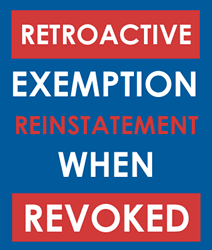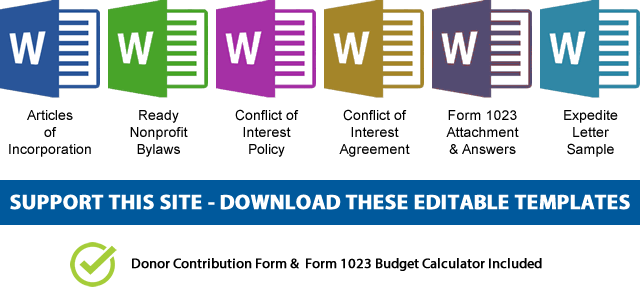What is Automatic Revocation of Tax Exemption?
 When a tax-exempt nonprofit organization’s 501c3 exemption status is automatically revoked by the IRS, the organization is no longer exempt from federal income tax, and almost all States will revoke the local tax-exemption status as well by default. There are many reasons that the IRS may revoke an exemption status but the most common one is failure to file the IRS form 990 annual return for three consecutive years.
When a tax-exempt nonprofit organization’s 501c3 exemption status is automatically revoked by the IRS, the organization is no longer exempt from federal income tax, and almost all States will revoke the local tax-exemption status as well by default. There are many reasons that the IRS may revoke an exemption status but the most common one is failure to file the IRS form 990 annual return for three consecutive years.
There are many 501c3 exempt organizations who find themselves in hot water when they find out that their exemption status has been revoked and the panic sets in. This is a serious problem as without the tax exemption reinstatement not only your future donations and revenue won’t be tax deductible; if the exemption status is not reinstated, you’re liable for paying due taxes on all your revenue for the past three years as well.
If you’re reading this page, you probably already have a revocation letter from the IRS, a big problem on your hand, and it needs to be fixed right away.
How to get your nonprofit 501c3 exemption status reinstated
To have a better understanding of automatic revocation of nonprofits, there are few facts you need to know:
- Donors can deduct contributions made before an organization’s name appears on the Automatic Revocation List.
- An automatic revocation is effective on the original filing due date of the third annual return or notice.
- The Internal Revenue Service (IRS) publishes the list of organizations whose tax-exempt status was automatically revoked because of failure to file a required Information Return Form 990, 990-EZ, 990-PF or Form 990-N (e-Postcard) for three consecutive years.
- You’ll be required to file U.S. Corporation Income Tax Return, due by the 15th day of the 3rd month after the end of an organization’s tax year.
501c3 Tax Exemption Reinstatement
First resist the urge to do the Tax exemption reinstatement application yourself. (Or at least all by yourself). You’re already in legal trouble and you only get one shot at it. Even though the application process is the same as applying for tax exemption, there are several factors that are against you already. One is that you dropped the ball for three years, the other is the dreaded Reasonable Cause statement.
- The reasonable cause letter for retroactive reinstatement should be carefully drafted to show a detailed description of all the facts and circumstances about why the organization failed to file its form 990s, how it discovered the failure, and the steps it has taken or will take to avoid or mitigate future failures. Most importantly it needs to establish that it was a non-willful act.
- If you fail to sufficiently make your legal case, you’ll be on the hook for past due taxes and the collapse of your organization. I offer tax exemption reinstatement services to a select few, and I’m very picky about who I choose to help. However use the contact page and contact me. If nothing else, I can’t at least put you in the right direction.
Knowing that, there are three ways to reinstate your tax exemption status but they depend on your circumstances, and here we’re strictly dealing with public charities recognized under section 501(c)(3) of the Internal Revenue Code whose tax-exemption was automatically revoked:
501c3 Retroactive Reinstatement Process (Within 15 Months)
Organizations that cannot use the Streamlined Retroactive Reinstatement Process (such as those that were required to file Information Return Form 990 or Form 990-PF for any of the three years that caused revocation or those that were previously auto-revoked) may have their tax-exempt status retroactively reinstated to the date of revocation if they:
- Complete and submit Form 1023 with the appropriate user fee not later than 15 months after the later of the date on the organization’s revocation letter (CP-120A) or the date the organization appeared on the Revocation List on the IRS website.
- Include with the application a statement establishing that the organization had reasonable cause for its failure to file a required annual return for at least one of the three consecutive years in which it failed to file.
- Include with the application a statement confirming that it has filed required form 990 returns for those three years and for any other taxable years after such period and before the post-mark date of the application for which required returns were due and not filed.
- File properly completed and executed paper annual returns for the three consecutive years that caused the revocation and any following years.
501c3 Retroactive Reinstatement (After 15 Months)
Previously tax-exempt nonprofits that apply for retroactive reinstatement of their status more than 15 months after the later of the date on the organization’s revocation letter (CP-120A) or the date the organization appeared on the Revocation List on the IRS website may have their tax-exempt status retroactively reinstated to the date of revocation if they:
- Satisfy all of the requirements described under the Retroactive reinstatement (within 15 months) procedure EXCEPT that the reasonable cause statement the organization includes with its application must establish reasonable cause for its failure to file a required annual return for all three consecutive years in which it failed to file.
- These organizations should check the appropriate box (Section 6) when submitting Form 1023 electronically.
501c3 Post-Mark Date Reinstatement
501c3 Organizations may apply for retroactive reinstatement effective from the post-mark date of their application if they:
- Complete and submit Form 1023 or Form 1023-EZ (PDF) with the appropriate user fee.
- These organizations should check the appropriate box (Section 7) when submitting Form 1023 or 1023-EZ electronically.
What to do for your State Tax Exemption Revocation?
As I mentioned earlier, when the IRS revokes a federal tax exemption status, your state will naturally follows suit and will revoke your state exemption status as well. This is a double edged sword as not only you have to convince the federal government to not punish you and give you back your exemption status; you also have to notify and petition the state to do the same.
The good news is that most cases, the incorporating state will honor the IRS’s reinstatement and will reinstate the nonprofits’ exemption statuses that were revoked by requests. However, your state won’t reinstate it automatically, you have to petition the state to consider it.
 NOTE: If you’d like to receive the following organizing documents:
NOTE: If you’d like to receive the following organizing documents:- Nonprofit Articles of Incorporation,
- Nonprofit Bylaws,
- Nonprofit Conflict of Interest Policy,
- Conflict of Interest Policy Acknowledgment,
- Form 1023 Attachment with all the answers,
- Form 1023 Expedite Letter template,
- and Donor Contribution Form
in Microsoft Word Document format, please consider making a donation and you’ll get to download them immediately. Not only they're worth well over $1000 in value, they will save you weeks of copy pasting and formatting as they are ready to go templates which only need changing names and addresses.

